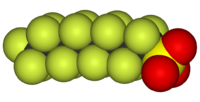
Photo from wikipedia
Organic contaminants such as pharmaceuticals, personal care products (PPCPs) and other emerging contaminants (ECs) are known to persist in the aquatic environment and many are indicated as endocrine, epigenetic, or… Click to show full abstract
Organic contaminants such as pharmaceuticals, personal care products (PPCPs) and other emerging contaminants (ECs) are known to persist in the aquatic environment and many are indicated as endocrine, epigenetic, or other toxicants. Typically, the study of PPCPs/ECs in the aquatic environment is limited to their occurrence dissolved in river water. In this study, accumulation and spatial distribution of thirteen PPCPs/ECs were assessed in aquatic sediment (n = 23), periphyton (biofilm, n = 8), plants Callitriche sp. (n = 8) and Potamogeton sp. (n = 7) as well as amphipod crustaceans (Gammarus pulex, n = 10) and aquatic snails (Bithynia tentaculata, n = 9). All samples (n = 65) were collected from the Hogsmill, Blackwater and Bourne Rivers in southern England. Targeted PPCPs/ECs included pharmaceuticals, plasticisers, perfluorinated compounds, illicit drugs and metabolites. Extraction from solid matrices occurred using ultrasonic-assisted extraction followed by an in-house validated method for solid-phase extraction and subsequent liquid-chromatography tandem mass-spectrometry. Field-derived bioconcentration-factors and biota-sediment accumulation-factors were determined for all studied biota. Residues of studied contaminants were found in all sediment and biota. Concentrations of contaminants were generally higher in biota than sediment. Evidence suggests that the studied aquatic plants may effectively degrade bisphenol-A into its main transformation product hydroxyacetophenone, potentially mediated by cytochrome p450 and internalisation of contaminants into the cellular vacuole. A positive association between both hydrophobicity and PFC chain length and contaminant accumulation was observed in this work. Only PFCs, plasticisers and HAP were classified as either 'bioaccumulative' or 'very bioaccumulative' using BCF criteria established by guidelines of four governments. Contaminants appeared to be differentially bioaccumulative in biota, indicating there may be a need for a species-specific BCF/BSAF classification system. These data form a detailed accounting of PPCP/EC fate and distribution in the aquatic environment highlighting accumulation at lower trophic levels, a potential source for higher organisms.
Journal Title: Environmental pollution
Year Published: 2018
Link to full text (if available)
Share on Social Media: Sign Up to like & get
recommendations!